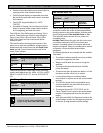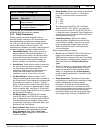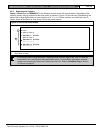
D9412GV3/D7412GV3 | Program Entry Guide | 2.0 Panel and Area Wide Parameters EN | 78
Bosch Security Systems, Inc. | 10/11 | F01U170807-02
M## CC Address 1 [through 16]
Default: Refer to the program record sheet
Selection: Yes or No
Yes
This menu item appears at this
keypad address.
No
This menu item does not appear at
this keypad address.
Programming this prompt determines at which CC
address setting this menu item appears.
2.12 Relay Parameters
Relays provide dry contact (normally open or
normally closed) outputs for LED annunciation and
other applications as well as wet voltage outputs
(12 VDC on or off) for basic alarm system functions
(such as Bell Output or Reset Sensors). The
applications are endless, but mainly, relays enhance
a system’s capacity to perform output functions.
Panel-Wide Relays: These relays provide an
output related to a panel-wide indication. For
annunciation, these relays can indicate system-
wide troubles for power and phone. They also
provide an overall control panel summary of
alarms, troubles, and supervisory conditions.
Area Relays: These relays provide an output by
the area to which the relay is assigned. An area
can have its own bell and sensor reset
indications. Relays can also indicate the area
armed state and whether any off-normal
conditions, such as a Force Arm, occurred.
On Board Relays: Three on-board 12 VDC
voltage outputs provide power when activated on
the control panel. These outputs are programmed
at the factory as Relays A, B, and C. Typically,
Relay A (Terminal 6) is used for the bell, Relay B
(Terminal 7) is used for an alternate alarm output
(such as another bell), and Relay C (Terminal 8)
is used for Sensor Reset (Relays B and C require
the optional D136 Relays).
Off-Board Relays: The D9412GV3 can also
control 128 (64 for the D7412GV3) dry-contact
form C relays when up to sixteen optional D8129
OctoRelay Modules are installed. These relays
are used for Area Relay, Panel-Wide Relay, and
Individual Point Fault Relays.
Relay Follows Point: Relays can also be used
to activate when a point programmed for P##
Relay Response Type (refer to P## Relay
Response Type on page 96) is off-normal or in
an alarm condition.
Relay Reports: When relay activity is reported to
the receiver (refer to Section 2.3 Routing on
page 17), on-board relays are reported as
follows:
A = 253
B = 254
C = 255
The others report as 001 to 128. The Relay
Report is RELAY SET RELAY # rrr when the
relay is turned on and RELAY RESET RELAY #
rrr when the relay is turned off. Relay Reports are
also printed on the local printer and stored in the
control panel memory log.
Controlling Relays: Relays can activate
depending upon conditions that exist with the
control panel. In addition, the user can control
relays by using the Change Relay? function,
Relay On/Relay Off skeds, and the Remote
Account Manager.
Before programming your relays:
Do not use the CHANGE RELAYS? function to
toggle relays reserved for special functions.
Special function relays are Area and Panel Wide
Relay functions as well as relays assigned to CC
Enter Key Relay and P## Relay Response
Type.
Relay C is always on. Assigning any other relay
(1 to 128, A or B) deactivates Relay C so this
output can be used for other functions. When
Relay C is programmed for A# Rest Sensors,
power is always supplied from Terminal 8 of the
control panel.
Relay Restoration: The status of relays after
programming or resetting the control panel might
restore automatically or require manual
restoration. All relays are turned off after the
control panel resets. The control panel checks
certain relay functions every minute and resumes
the correct state after the reset. Other relays
must be manually set to the correct state using
the Change Relay Function (COMMAND 54).


















